You’ll discover steam casting offers an accessible entry into professional metalworking that revolutionizes your artistic capabilities. This cost-effective method uses inexpensive sand and clay materials while delivering intricate details and superior surface finishes that traditional techniques often miss. You’ll enjoy enhanced safety with lower operating temperatures and minimal fumes, plus unprecedented creative control over complex geometries and unique patina effects. The skills you develop open doors in sculpture, jewelry design, and manufacturing industries while positioning you advantageously in sustainable production markets—and there’s much more to uncover.
Historical Significance of Steam Casting in Metalworking
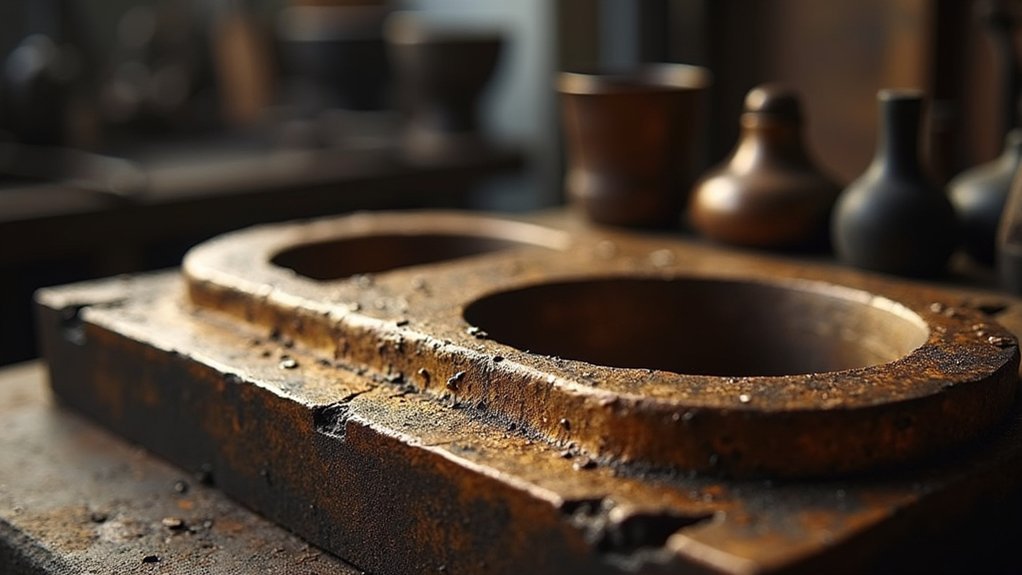
Revolution transformed metalworking forever when steam casting emerged during the industrial age.
You’ll discover that steam-powered machinery revolutionized mold preparation and metal pouring, dramatically enhancing efficiency in metalworking processes. This breakthrough enabled mass production of intricate metal components, driving advancements across automotive and aerospace industries throughout the 19th and 20th centuries.
Steam casting’s evolution coincided with new materials and alloys development, expanding your creative possibilities as an artist or craftsman.
Unique Artistic Possibilities Through Steam Casting Techniques
While traditional casting methods limit your design complexity, steam casting techniques reveal extraordinary artistic possibilities that’ll transform your metalworking practice.
You’ll achieve intricate details and complex geometries that conventional methods simply can’t match, opening doors to innovative sculptural forms.
Steam casting delivers superior surface finishes with smoother textures that enhance your artistic vision.
You’ll discover unique patina effects and surface treatments that add remarkable depth and character to each piece.
The versatility of molds lets you experiment with both functional and decorative objects, expanding your creative horizons considerably.
This cost-effective approach uses readily available materials like sand, making advanced metalworking accessible whether you’re a professional artist or passionate hobbyist exploring new creative territories.
Cost-Effective Alternative to Traditional Casting Methods
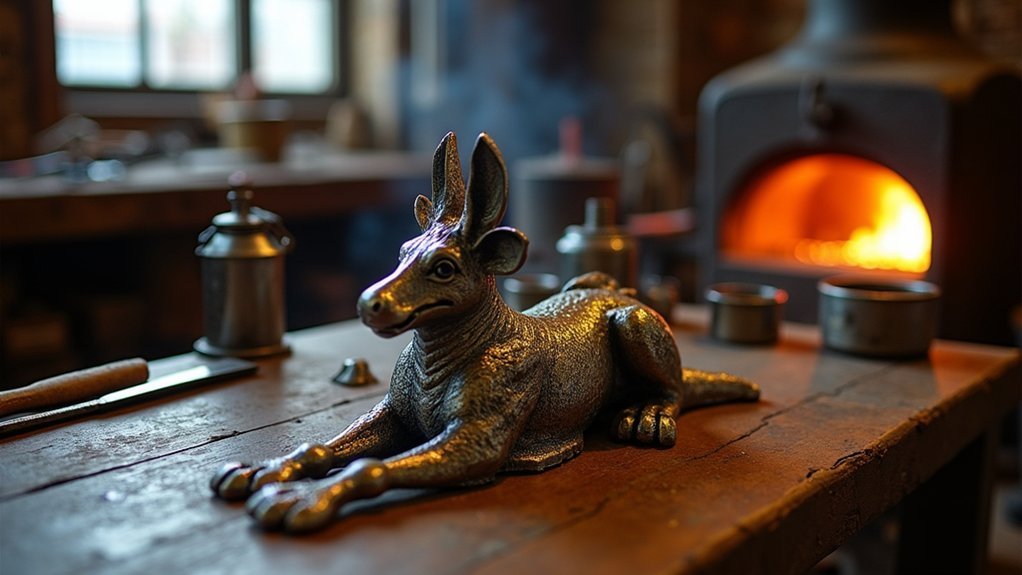
Beyond these creative advantages, steam casting delivers exceptional value that makes advanced metalworking affordable for any budget.
You’ll find this cost-effective alternative uses inexpensive materials like sand and clay instead of expensive molds and tooling required for investment or die casting. Unlike CNC machining or 3D printing technologies that demand significant financial investment, steam casting lets you create simple patterns with minimal upfront costs.
You can scale projects from small decorative pieces to larger functional items without incurring additional expenses associated with traditional casting setups.
This accessibility empowers DIY enthusiasts and artists to achieve intricate detailing and complex designs while maintaining budget-friendly operations.
Steam casting removes financial barriers that typically prevent hobbyists from exploring metalworking, letting you pursue creative projects without significant financial risk.
Enhanced Detail and Texture Capabilities
You’ll discover that steam casting excels at capturing intricate details that traditional methods often miss or blur.
The steam process creates complex surface textures by manipulating temperature and pressure, giving you control over whether your piece has smooth, refined areas or deliberately rough, organic finishes.
You can replicate even the most delicate patterns with remarkable precision, as the steam works with advanced mold materials to transfer every subtle nuance from your original design to the final metal artwork.
Steam Creates Fine Details
When you harness steam’s controlled pressure and temperature during casting, you’ll achieve intricate details that traditional methods simply can’t match. The steam allows molten metal to flow into the finest crevices of your mold, creating a thinner, more uniform layer that captures every nuance of your design.
You’ll notice how steam casting reproduces delicate features and complex patterns that would be impossible with conventional techniques. The precise pressure control helps eliminate surface imperfections while enhancing texture definition.
This means you can create sculptures with incredibly fine details, from subtle facial expressions to intricate decorative elements. The technique’s ability to fill narrow spaces and reproduce minute details gives you unprecedented creative freedom, enabling artistic expressions that push the boundaries of traditional metalworking.
Complex Surface Textures
Steam casting’s precision extends beyond fine details to encompass an extraordinary range of surface textures that transform your metal art into tactile masterpieces.
You’ll discover how fine sand and precise mold preparation create intricate patterns that elevate your work’s visual impact. Steam promotes superior sand adhesion, eliminating surface defects while enabling complex texture replication.
You can experiment with resin-coated sands and varied mold materials to achieve everything from mirror-smooth finishes to elaborate natural patterns.
Advanced steam methods let you replicate detailed designs found in nature or other art forms with remarkable accuracy. By manipulating cooling rates during casting, you’ll control surface finishes intentionally, using texture as another tool for artistic expression in your metal creations.
Precision Pattern Replication
Mastery of precision pattern replication transforms steam casting into a revolutionary tool for capturing the most intricate artistic visions with unprecedented accuracy.
You’ll discover that steam’s unique properties enable flawless detail transfer from your original patterns to final metal pieces, ensuring every texture and nuance appears exactly as intended.
Steam casting’s precision pattern replication capabilities offer three distinct advantages:
- Consistent reproduction – Create multiple identical pieces without quality degradation across editions.
- Complex detail capture – Preserve intricate textures and fine surface elements that traditional methods can’t replicate.
- Enhanced surface quality – Achieve smoother finishes and sharper detail definition through steam’s superior molding properties.
You’ll find this precision particularly valuable when working with 3D-printed patterns or CAD-designed molds, where maintaining exactness between digital concept and physical artwork becomes essential for professional results.
Safety Advantages Over High-Temperature Casting Processes
While traditional casting methods expose you to extreme temperatures that can cause severe burns, steam casting operates at considerably lower heat levels, dramatically reducing your risk of injury. The safety advantages extend beyond temperature reduction—you’ll work in an environment with minimal harmful fumes and vapors.
| Traditional Casting | Steam Casting |
|---|---|
| Heavy protective gear required | Lighter safety equipment needed |
| Extended exposure to hazards | Quick cooling times |
| High burn risk from molten metal | Lower temperature operation |
| Toxic fume generation | Minimal vapor production |
You’ll find steam casting more accessible as a beginner since safety equipment requirements aren’t as stringent. The quicker cooling times reduce your exposure duration to hazardous conditions, while the lower-risk environment encourages creative experimentation without compromising safety.
Equipment and Material Requirements for Steam Casting
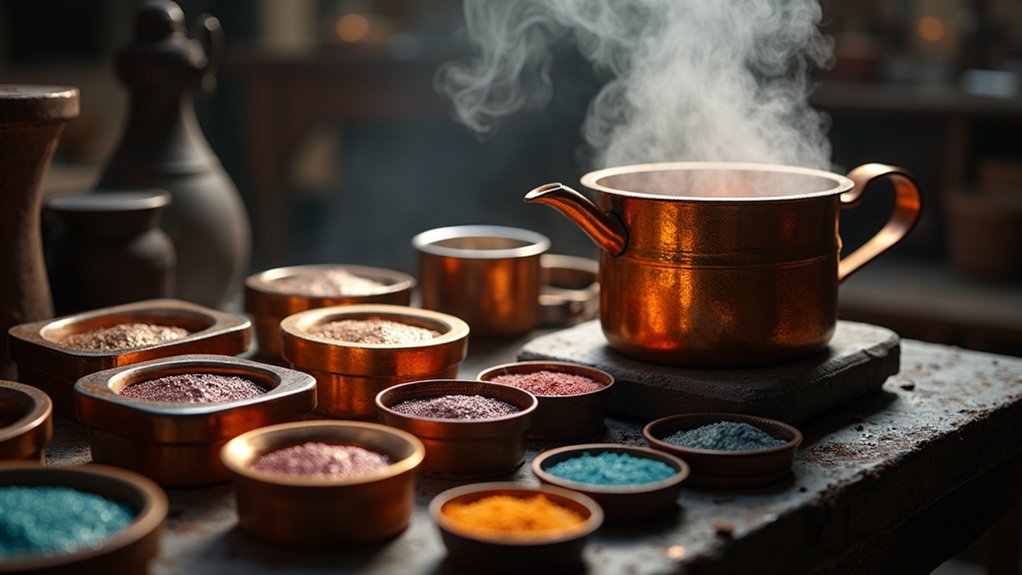
You’ll need specific equipment to get started with steam casting, beginning with a steam generator, mold box, and vacuum chamber that work together to control steam flow and pressure.
Your material selection forms the foundation of successful casting – you’ll work with high-quality casting sand, clay, and water to build molds that can handle molten metal temperatures.
The metals you choose, whether aluminum, bronze, or brass, will depend on your artistic vision and the final properties you want in your finished piece.
Essential Casting Equipment Types
Five fundamental equipment categories form the backbone of any successful steam casting operation.
You’ll need steam generation systems to create the pressure required for effective mold filling.
Mold-making equipment helps you craft precise forms that withstand extreme temperatures.
Metal handling tools guarantee safe transportation and pouring of molten materials.
Temperature control devices maintain ideal conditions throughout the casting process.
Safety equipment protects you from burns and other hazards.
Here’s your essential equipment breakdown:
- Steam generators and pressure vessels – These create and maintain the steam pressure necessary for forcing molten metal into intricate mold cavities.
- Pattern-making tools and mold frames – You’ll use these to shape casting sand into precise forms that capture fine artistic details.
- Pouring ladles and handling tools – These specialized implements allow safe manipulation of extremely hot molten metals during the casting process.
Steam System Components
Because steam casting relies on precise pressure control and material handling, understanding each system component becomes critical for producing quality metal art pieces. Your steam system components work together to create the controlled environment needed for successful casting.
| Component | Material | Function |
|---|---|---|
| Steam Generator | Steel/Iron | Produces controlled steam pressure |
| Material Reservoir | Heat-resistant metal | Holds molten metal before pouring |
| Mold | Sand and clay mixture | Shapes final cast object |
| Ventilation System | Various materials | Removes harmful vapors safely |
| Safety Equipment | Heat-resistant materials | Protects against burns and exposure |
You’ll need to maintain these steam system components regularly, checking the generator’s pressure levels and inspecting mold integrity. Each component must withstand extreme temperatures while working with materials like aluminum, bronze, and metal alloys to achieve your desired artistic results.
Metal and Sand Materials
Metal selection forms the foundation of successful steam casting, with aluminum, bronze, and brass leading as preferred choices for their exceptional strength, durability, and striking aesthetic appeal in artistic applications.
When you’re starting out, understanding which metal used will determine your project’s success and final appearance.
Your sand mixture requires equal attention to detail. Green sand combines silica sand, clay, and water to create an effective molding medium that captures intricate details while remaining flexible enough for easy removal.
Consider these essential material requirements:
- Metal types – Aluminum melts at 660°C, while bronze requires higher temperatures at 950°C
- Sand composition – Silica sand mixed with clay and water for ideal moldability
- Quality standards – Pure metals guarantee consistent results and superior finished pieces
Creative Control and Design Flexibility Benefits
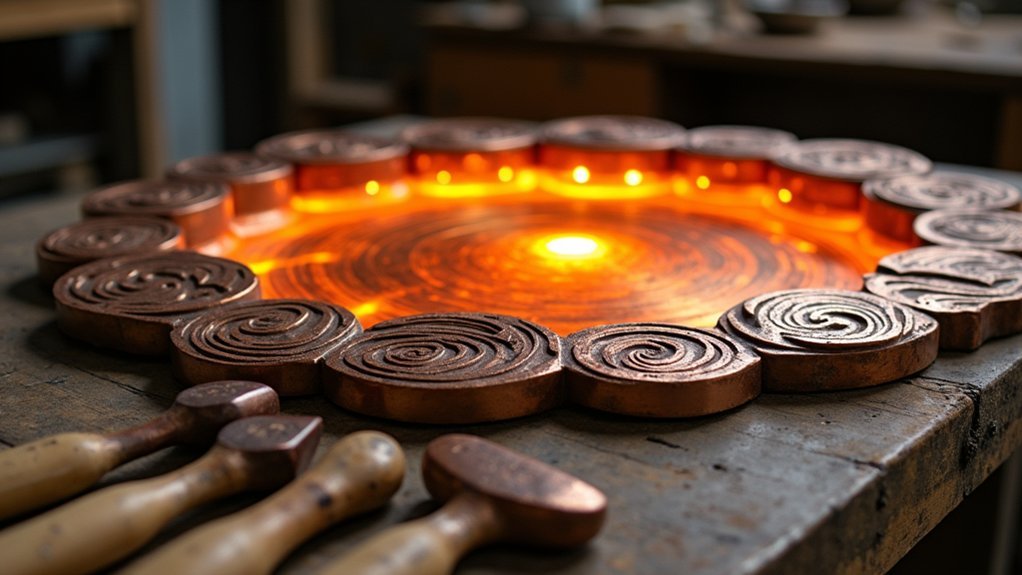
When you choose steam casting for your metal art projects, you’ll discover unprecedented creative control that transforms how you approach design.
You can adapt intricate designs in real-time, giving you flexibility that traditional casting methods simply can’t match. This technique lets you manipulate mold designs during the process, allowing you to refine shapes and details until you achieve your desired artistic outcome.
You’ll also gain the freedom to experiment with various metal alloys, enhancing both the artistic quality and uniqueness of your pieces.
Whether you’re creating large-scale sculptures or small detailed works, steam casting provides a versatile platform for exploring diverse themes.
You can seamlessly combine aesthetics with utility, producing both functional and decorative items that broaden your creative horizons.
Professional Applications in Contemporary Metal Art
Contemporary metal artists worldwide have embraced steam casting as a cornerstone technique for creating gallery-worthy pieces that command attention in prestigious exhibitions.
You’ll discover that this method bridges traditional craftsmanship with cutting-edge innovation, making it essential for modern artistic careers.
Professional applications include:
- Historical Restoration Projects – You can replicate ancient artifacts and architectural elements with unprecedented accuracy.
- Commercial Art Installations – You’ll create large-scale decorative pieces for hotels, museums, and public spaces.
- Cross-Disciplinary Collaboration – You’ll work with professionals from STEM fields, integrating CAD software and 3D printing technologies.
Steam casting’s cost-effectiveness and versatility allow you to experiment with complex designs while maintaining professional quality standards.
You’ll address casting defects systematically, ensuring durable outcomes that meet contemporary aesthetic expectations and client specifications.
Skill Development and Career Advancement Opportunities
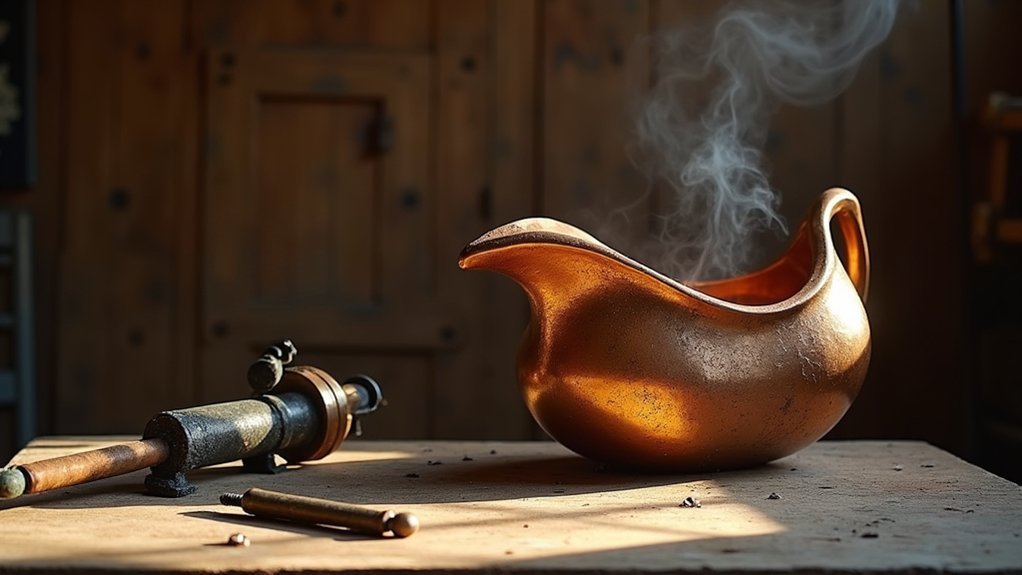
As you master steam casting fundamentals, you’ll unfasten specialized skills that set you apart in competitive creative markets. This skill development opens doors across sculpture, jewelry design, and industrial manufacturing where skilled artisans command premium positions.
Your expertise becomes increasingly valuable as industries prioritize innovative and sustainable production methods, giving you a competitive edge in growing job markets.
As demand for sustainable manufacturing grows, your steam casting expertise positions you ahead of competitors in expanding creative markets.
Steam casting mastery creates networking opportunities within creative communities and art organizations that recognize metal casting as essential contemporary art practice. Each project you complete strengthens your portfolio, demonstrating ability to craft intricate, durable metal pieces that impress potential employers and clients.
This specialized knowledge positions you for career advancement in both artistic and technical fields where metalworking expertise remains highly sought after.
Frequently Asked Questions
What Is the Purpose of Metal Casting?
You’ll transform molten metal into solid objects by pouring it into molds, creating intricate shapes that’d be difficult through other methods while achieving cost-effective, versatile production for decorative pieces and industrial components.
What Is Steam Casting?
Steam casting uses steam pressure to push molten metal into molds. You’ll achieve intricate details and precise designs while working with non-ferrous metals like aluminum and bronze in your artistic creations.
What Is the Principle of Metal Casting?
You pour molten metal into a mold cavity that’s shaped like your desired object. When the metal cools and solidifies, it takes the mold’s form, creating your finished casting piece.
What Is Metal Casting Art?
You’ll create sculptural artworks by pouring molten metals like bronze, aluminum, or iron into molds. You’ll start with clay or wax models, then use techniques like lost-wax casting to achieve intricate designs and textures.
In Summary
You’ll discover that steam casting opens doors to incredible artistic possibilities while keeping costs manageable and safety risks low. You’re gaining access to a technique that’s shaped metalworking history and continues driving contemporary art forward. Whether you’re pursuing personal creative goals or professional advancement, you’ll find steam casting gives you the control, detail, and flexibility needed to transform your metal art vision into reality.



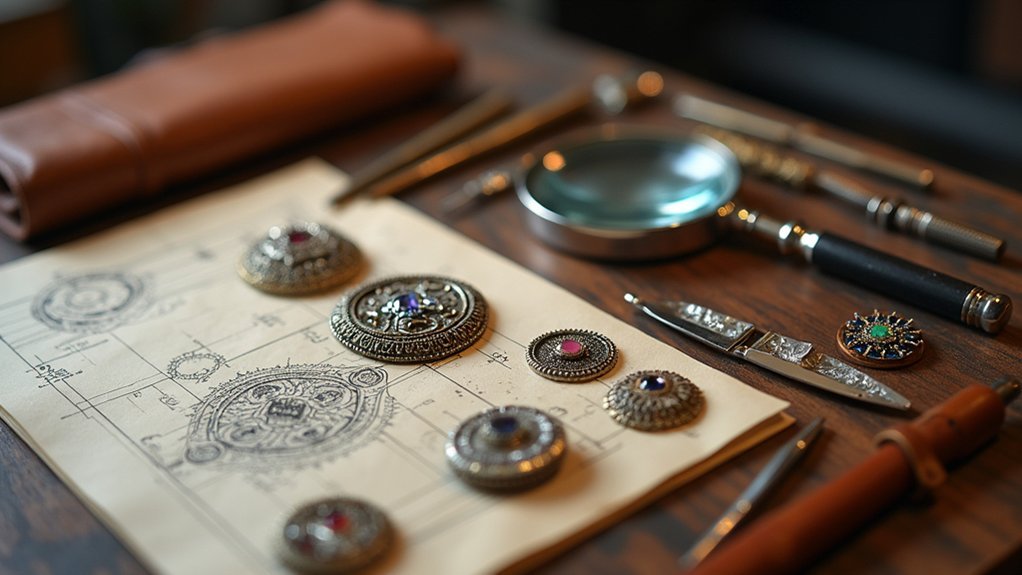

Leave a Reply